
Box 1.0 Connectivity

The guide begins with the assessment of connectivity impacts to habitat networks (Box 1.1). Habitat networks, as defined in Section 3 "Habitat Fragmentation Background, Concepts and Terminology", consist of both terrestrial and aquatic resource networks.
Box 1.1 Terrestrial Habitat Network: Does the alternative prevent or impair terrestrial wildlife movement within or between habitat cores, or within an island?
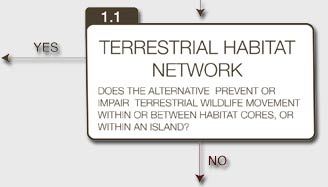
The practitioners will determine the potential of the project alternative to prevent or impair terrestrial wildlife movement within or between cores (along a corridor), or within an island. Direct impacts to habitat cores, habitat islands or impairment impacts should be assessed throughout the length of the entire alternative. The practitioner should assess the number of impacts, the acreage of direct impact and the affects of impairment. An affirmative answer leads the practitioners to a list of potential mitigation solutions (Box 1.1A). A negative answer (lack of terrestrial habitat network impacts) directs the practitioner to Box 1.2 Aquatic Habitat Network.
Box 1.1A Terrestrial Habitat Network Potential Solutions (Steps 1-4)
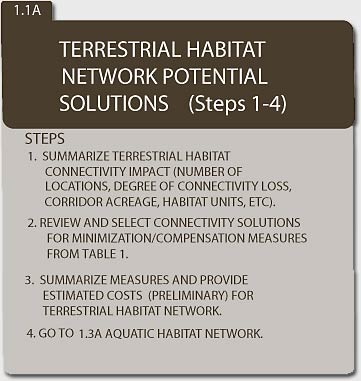
Box 1.1A describes a 4 step process to develop a preliminary minimization/mitigation strategy and preliminary cost estimate for the alternative under consideration.
Step 1. Summarize terrestrial habitat connectivity impact (number of locations, degree of connectivity loss (full or partial), corridor acreage, habitat units, etc).
All Terrestrial Habitat Network impacts for the alternative should be considered collectively. The measure of impact such as number of corridors, corridor acreage, habitat units, or other measures may be used to quantify the impact of the entire project alternative. The quantitative analysis will serve as the baseline measure of habitat and connectivity loss. Mitigation will be designed to offset the baseline impact. Natural systems may require 3 to 5 years or longer before developing and becoming fully functional. Mitigation ratios may exceed a 1 to 1 ratio of mitigation to impact. Factors that determine mitigation ratios typically include the degree of functional loss (full or partial) that are lost by the impacted habitat type, duration of time required for re-establishment of a habitat type and function, and some measure of rarity of the habitat type. Agencies may provide input on the mitigation ratio that will be required.
Step 2. Review and select terrestrial connectivity solutions for minimization/compensation measures from summary table of connectivity mitigation solutions. The mitigation solutions for connectivity impacts can be reviewed and assessed for applicability to the project impacts based on species group, opportunity, effectiveness and cost.
Step 3. Summarize measures and provide estimated costs (preliminary) for Terrestrial Habitat Network. A summary of Terrestrial Habitat Corridor avoidance, minimization, and mitigation measures should be prepared. The number of crossings, acreage, habitat unit totals, and a preliminary estimate of costs for the measures should be totaled. This will be carried into the summary prepared in Box 3.0 Habitat Fragmentation Summary Chart.
Step 4. Go to 1.2 Aquatic Habitat Network
Once the terrestrial habitat network is evaluated for the alternative the practitioner is directed to evaluate connectivity impacts to the aquatic habitat network.
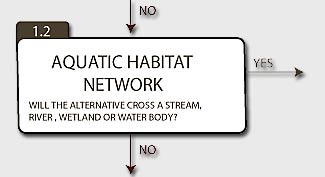
Box 1.2 Aquatic Habitat Network: Will the Alternative cross a stream, river, wetland or water body?
The first question directs the practitioner to assess if an alternative will cross part of an aquatic habitat network (stream, river, wetland or waterbody). If there are no crossings (and no impacts) then the practitioner is directed to 2.0 Patch. If the project crosses part of an aquatic habitat network then the practitioner is directed to Box 1.3 to assess if the crossing has the potential to become a barrier or impair connectivity.
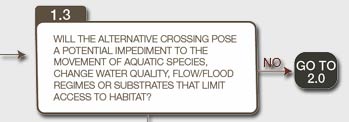
Box 1.3. Aquatic Habitat Network: Will the alternative crossing pose a potential impediment to the movement of aquatic species, or change water quality, flow/flood regimes or substrates that limit access to habitat?
The practitioner will determine the potential of the project alternative to prevent or impair aquatic species movement within or between cores (along a corridor). Direct impacts to cores or impairment of connectivity should be assessed throughout the length of the entire alternative. The practitioner should assess the number of impacts, the acreage of direct impact and the effects of impairment. An affirmative answer leads the practitioner to a list of potential mitigation solutions (1.3A). A negative answer (lack of aquatic habitat network impacts) directs the practitioner to 2.0 Patches.
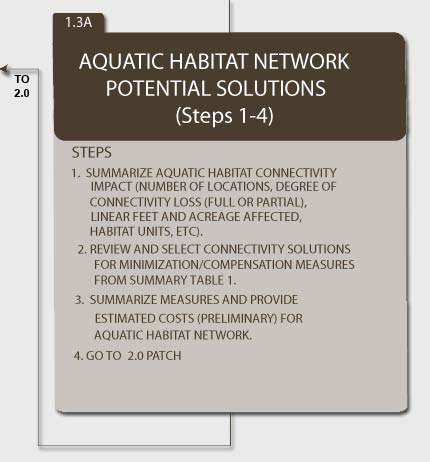
Box 1.3A Aquatic Network Potential Solutions
Box 1.3A describes a 4 step process to develop a preliminary aquatic habitat network minimization/mitigation strategy and preliminary cost estimate for the alternative under consideration.
Step 1. Summarize aquatic habitat connectivity impact (number of locations, degree of connectivity loss (full or partial), linear feet and acreage affected, habitat units, etc).
All Aquatic Habitat Network impacts for the alternative should be considered collectively. The measure of impact such as number of corridors, corridor acreage, habitat units, or other measures (stream mitigation impact units) may be used to quantify the impact of the entire project alternative. The quantitative analysis will serve as the baseline measure of aquatic habitat and connectivity loss. Mitigation will be designed to offset the baseline impact. Mitigation ratios have been discussed in Terrestrial Habitat Networks (1.1b).
Step 2. Review and select aquatic connectivity solutions for minimization/compensation measures from summary table of connectivity mitigation solutions. The mitigation solutions for connectivity impacts can be reviewed and assessed for applicability to the project impacts based on species trophic level, opportunity, effectiveness and cost.
Step 3. Summarize measures and provide estimated costs (preliminary) for Aquatic Habitat Network.
A summary of Aquatic Habitat Corridor avoidance, minimization, and compensatory mitigation measures should be prepared. The number of crossings, acreage, habitat unit totals, and a preliminary estimate of costs for the measures should be totaled. This will be carried into the summary of developed in Box 3.0 Habitat Fragmentation Summary Chart.
Step 4. Go to Box 2.0 Patch
Once completed, the practitioner is directed to continue the process to assess for impacts to Patch (2.0).